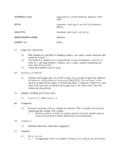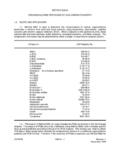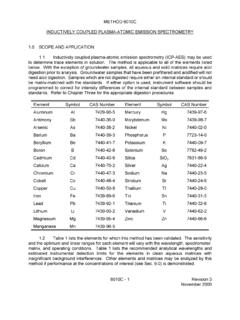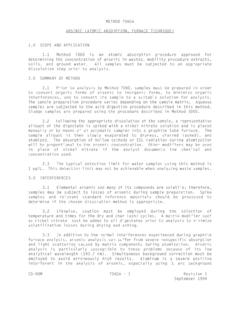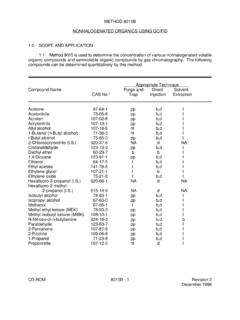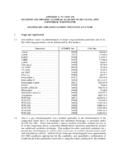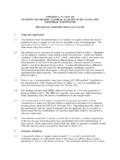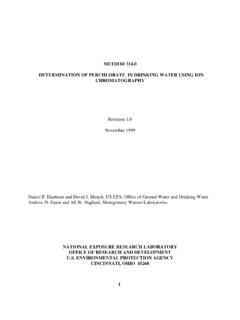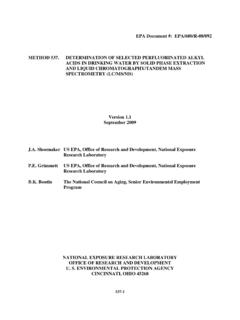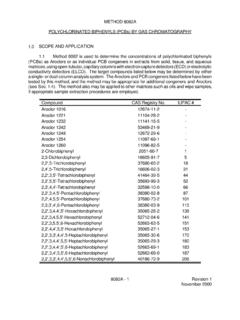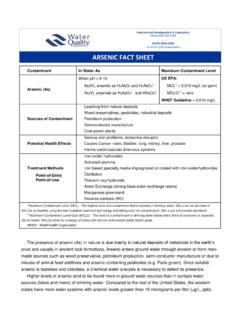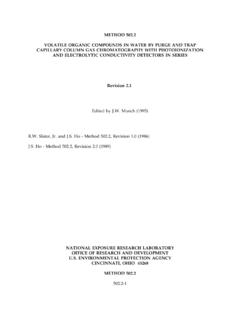Transcription of N-Hexane Extractable Material (HEM; Oil and Grease) and ...
1 United StatesOffice of WaterEPA-821-R-98-002 Environmental Protection Washington, DC 20460PB99-121949 AgencyFebruary 1999 Method 1664, Revision A: N-Hexane Extractable Material (HEM; Oiland Grease) and Silica Gel TreatedN- hexane Extractable Material (SGT-HEM; Non-polar Material ) by Extractionand GravimetryiiAcknowledgmentsThis method was prepared under the direction of William A. Telliard of the Engineering andAnalysis Division within EPA's Office of Water. This document was prepared under EPA ContractNo. 68-C-98-139by DynCorp Information and Enterprise method has been reviewed by the Engineering and Analysis Division, EnvironmentalProtection Agency, and approved for publication.
2 Mention of trade names or commercial productsdoes not constitute and endorsement or recommendation for of and of and and Collection, Preservation, and and Analysis and of Definitions and 1664 February 1999ivIntroductionAs a party to the Montreal Protocol on Substances that Deplete the Ozone Layer and as required bylaw under the Clean Air Act Amendments of 1990 (CAAA), the United States is committed tocontrolling and eventually phasing out the use of chlorofluorocarbons (CFCs). In support of theseefforts, Method 1664 was developed by the United States Environmental Protection Agency Office ofScience and Technology to replace previously used gravimetric procedures that employed Freon-113,a Class I CFC, as the extraction solvent for the determination of oil and grease and 1664 is a performance-based method applicable to aqueous matrices that requires the use ofn- hexane as the extraction solvent and gravimetry as the determinative technique.
3 Alternativeextraction and concentration techniques are allowed, provided that all performance specifications aremet. In addition, QC procedures designed to monitor precision and accuracy have been incorporatedinto Method concerning this method should be directed to:William A. EPAE ngineering and Analysis Division, MC 4303 Office of Science and Technology401 M Street, SWWashington, 20460 Requests for additional copies of this method should be direct to:National Technical Information Service5285 Port Royal RoadSpringfield, VA 22161 Phone:(703)487-4650(800) 553-6847 Document No. EPA National Center for Environmental Publications and Information11029 Kenwood RoadCincinnati, OH 45242 Phone:(513) 489-8190(800) 490-9198 Document No.
4 EPA-821-R-98-002 Method 1664 February 19991 Method 1664, Revision An- hexane Extractable Material (HEM; Oil and Grease) and Silica GelTreated N-Hexane Extractable Material (SGT-HEM; Non-polar Material )by Extraction and and method is for determination of N-Hexane Extractable Material (HEM; oil and grease) andn- hexane Extractable Material that is not adsorbed by silica gel (SGT-HEM; non-polarmaterial) in surface and saline waters and industrial and domestic aqueous materials that may be determined are relatively non-volatile hydrocarbons,vegetable oils, animal fats, waxes, soaps, greases, and related materials. The method is basedon prior Environmental Protection Agency (EPA) methods for determination of "oil andgrease" and "total petroleum hydrocarbons" (References and ).
5 Method is for use in the Environmental Protection Agency's (EPA's) survey andmonitoring programs under the Clean Water Act; the Resource Conservation and RecoveryAct; the Comprehensive Environmental Response, Compensation, and Liability Act; and otherEPA regulatory programs. "Oil and grease" is a conventional pollutant under the Clean WaterAct and codified at 40 CFR The term " N-Hexane Extractable Material " reflects thatthis method can used to determine materials other than oils and greases. Similarly, the term"silica gel treated N-Hexane Extractable Material " reflects that this method can be used todetermine Material that is not adsorbed by silica gel (non-polar Material ).
6 Method is not applicable to measurement of materials that volatilize at temperaturesbelow approximately 85EC. Petroleum fuels from gasoline through #2 fuel oil may bepartially lost in the solvent removal crude oils and heavy fuel oils contain a significant percentage of materials that are notsoluble in N-Hexane . Accordingly, recoveries of these materials may be method is capable of measuring HEM and SGT-HEM in the range of 5 to 1000 mg/L,and may be extended to higher levels by analysis of a smaller sample volume HEM and SGT-HEM in this method, the method detection limit (MDL) is mg/L andthe minimum level of quantitation (ML) is mg/L (Reference ).
7 Laboratory is permitted to modify the method to overcome interferences or lower the costof measurements, provided that all performance criteria in this method are met. Therequirements for establishing method equivalency are given in Sections and modification of this method, beyond those expressly permitted, shall be considered amajor modification subject to application and approval of alternate test procedures under 40 CFR and laboratory that uses this method must demonstrate the ability to generate acceptableresults using the procedure in Section 1664 February of 1-L sample is acidified to pH <2 and serially extracted three times with N-Hexane in aseparatory funnel.
8 The extract is dried over sodium solvent is distilled from the extract and the HEM is desiccated and weighed. If the HEMis to be used for determination of SGT-HEM, the HEM is redissolved in SGT-HEM determination, an amount of silica gel proportionate to the amount of HEMis added to the solution containing the redissolved HEM to remove polar materials. Thesolution is filtered to remove the silica gel, the solvent is distilled, and the SGT-HEM isdesiccated and is assured through calibration and testing of the extraction, distillation, andgravimetric and SGT-HEM are method-defined analytes; , the definitions of both HEM andSGT-HEM are dependent on the procedure used.
9 The nature of the oils and/or greases, andthe presence of Extractable non-oily matter in the sample will influence the Material measuredand interpretation of for terms used in this method are given in the glossary at the end of the , reagents, glassware, and other sample-processing hardware may yield artifacts thataffect results. Specific selection of reagents and purification of solvents may be materials used in the analysis shall be demonstrated to be free from interferences byrunning laboratory blanks as described in Section is cleaned by washing in hot water containing detergent, rinsing with tap anddistilled water, and rinsing with solvent or baking.
10 Boiling flasks that will contain theextracted residue are dried in an oven at 105 115EC and stored in a sulfate and silica gel fines have the potential to inflate results for HEM and SGT-HEM by passing through the filter paper. If the filter paper specified in this method isinadequate for removal of these fines, use of a filter is extracted from samples will vary considerably from source to source, dependingupon the diversity of the site being sampled. For those instances in which samples are thoughtto consist of complex matrices containing substances (such as particulates or detergents) thatmay interfere with the extraction procedure, a smaller sample may need to be collected toxicity or carcinogenicity of each reagent used in this method has not been preciselydetermined; however, each chemical should be treated as a potential health hazard.
